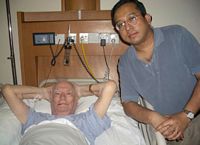 Yes I know that there have no posts here for a few days now. No, nothing’s wrong (thank you to those who emailed me, asking if all was well), there just hasn’t been much to post about.
Yes I know that there have no posts here for a few days now. No, nothing’s wrong (thank you to those who emailed me, asking if all was well), there just hasn’t been much to post about.
One of the things I have been doing is some investigation into the “wobbly Space Elevator” (non?) problem. I’ve been corresponding with Dr. Brad Edwards and Dave Lang about this (as well as reading what Blaise Gassend had to say about it) and am going to pony up the $31.50 to read the original paper by Lubos Perek to see what ignited all the fuss. At some future point, if I think I have something to add to this discussion, I will do so.
Glen Phillips is in town Friday night – I look forward to this concert with great anticipation.
Planning is still ongoing for this year’s Space Elevator Games. The two biggest changes from previous games are, of course, the length of the racecourse (now 1km) and that instead of a ribbon, the climbers will have to be ascending/descending a steel rope. The chances that anyone will attempt this competition with a power source other than a laser are somewhere between zero and nil.
Planning is also ongoing for the 2008 Space Elevator Conference. A full team has been assembled to organize this event and I, for one, am truly looking forward to it. It will also be very interesting to see how much Microsoft is truly interested in this idea. I had blogged earlier about Bryan Laubscher’s talk at Microsoft – perhaps this is another way that they are going to compete with Google? 🙂
The picture thumbnail, above, is probably one of the last (if not the last) pictures of Sir Arthur C. Clarke and was provided as part of a story by Saswato R. Das. Click on it for a slightly larger version (or access the story, of course).
Finally, about 30% of me thinks that this is a hoax…

Welcome back…
Space elevator “wobble”…
Well, duh! Of course there’ll be vibration in a Space Elevator cable. You can’t have a long taught cable like that without it trying to behave like a guitar string.
That’s why you need magnetic dampeners on either ends. As soon as an oscillation starts to build, the de-oscillation computer program instructs the rings holding the cable in place to magnetically shift in the direction of the oscillation, thus causing the cable’s movement to dampen.
As with anything new and wonderful, there’ll be many obstacles – but that’s what us hairless monkeys are so very, very good at overcoming.